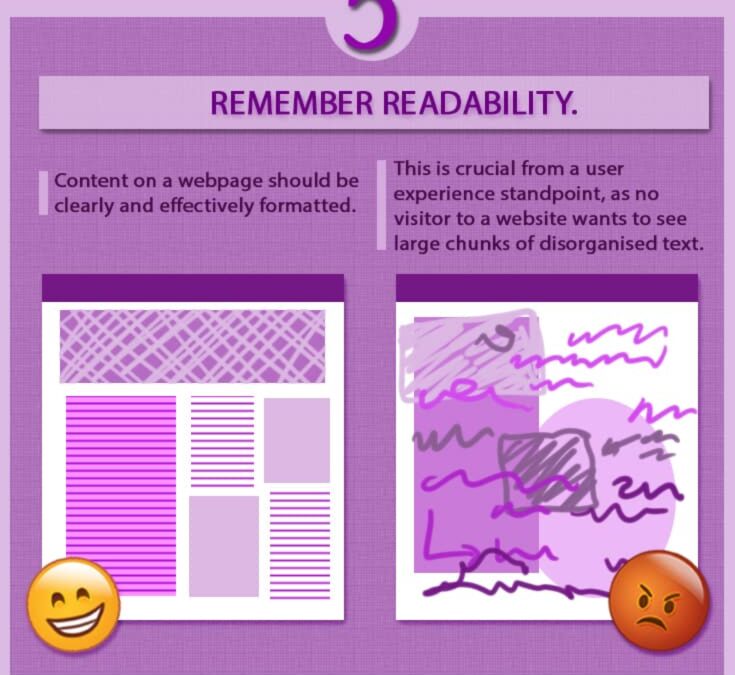Comsys Web design offers unsurpassed quality websites in any niche.
Are you looking for ways to reduce your website bounce rate? Want to stop visitors landing on your website and leaving straight away?
We share 10 tips to reduce your website bounce rate in this infographic.
Here’s a quick summary:
- Pay attention to page load time
- Easy navigation
- Focus on a great design
- Keep mobile top-of-mind
- Remember readability
- Shorter paragraphs
- Relevant keywords
- Convincing call-to-action
- Focus on an internal link strategy
- Ensure that links open in a new tab
Check out the infographic for more detail.
When it comes to running a successful website, there’s one metric that you simply can’t ignore: bounce rate. Bounce rate measures the percentage of visitors who land on your website and leave without engaging with any of its content.
A high bounce rate can be a troubling sign, indicating that something on your site isn’t resonating with your audience. Fortunately, there are several effective strategies you can implement to reduce your bounce rate and keep visitors engaged.
In this blog post, we’ll explore some key tips to help you achieve this goal.
Pay Attention to Page Load Time
In today’s fast-paced digital world, users expect websites to load quickly. In fact, a study by Google found that as page load time increases from one second to five seconds, the probability of bounce increases by 90%.
This highlights the critical importance of optimizing your website’s load time.
- Image Compression and Optimization: One of the primary factors that contribute to slow load times is large, unoptimized images. To address this issue, consider compressing and optimizing your images before uploading them to your website. There are various online tools and plugins available that can help you achieve this without sacrificing image quality.
- Minimize HTTP Requests: Every element on a webpage, such as images, scripts, and stylesheets, requires an HTTP request to load. The more requests your webpage makes, the longer it will take to load. To reduce the number of HTTP requests, consolidate and minify your CSS and JavaScript files, and use browser caching to store static resources locally on users’ devices.
- Choose a Reliable Hosting Provider: The hosting provider you choose can significantly impact your website’s load time. Opt for a hosting provider with a reputation for reliability and speed. Consider whether shared hosting, VPS hosting, or dedicated hosting is the best fit for your website’s needs.
Easy Navigation
A user-friendly and intuitive navigation structure is essential for keeping visitors on your website. If users can’t find what they’re looking for quickly, they’re more likely to bounce.
Here are some navigation tips to consider:
- Clear Menu Structure: Ensure that your website’s menu is clear, organized, and easy to understand. Use descriptive labels for menu items, and avoid overwhelming visitors with too many options. A simple, well-organized menu can make a significant difference in user experience.
- Breadcrumb Navigation: Implement breadcrumb navigation to help users understand their location within your website’s hierarchy. Breadcrumbs provide a trail of links that show users the path they’ve taken to reach their current page, making it easier for them to backtrack or explore related content.
- Search Functionality: Include a search bar prominently on your website, preferably at the top of the page. This allows users to quickly search for specific content, products, or information, reducing the likelihood of them bouncing due to frustration.
Focus on a Great Design
Your website’s design plays a crucial role in capturing visitors’ attention and keeping them engaged. A visually appealing and well-structured design can make a significant difference in reducing bounce rates.
- Clean and Uncluttered Layout: Avoid cluttering your webpages with excessive elements, such as ads, pop-ups, and distractions. A clean and uncluttered layout helps users focus on your content and makes for a more pleasant browsing experience.
- Consistent Branding: Maintain consistent branding elements across your website, including colors, fonts, and logos. Consistency helps build trust with your audience and reinforces your brand identity.
- Readable Typography: Choose readable fonts and font sizes to ensure that your content is easy to read. Pay attention to line spacing and contrast between text and background colors. Make sure your content is visually appealing and accessible on both desktop and mobile devices.
Keep Mobile Top-of-Mind
With the increasing use of smartphones and tablets, optimizing your website for mobile users is no longer optional—it’s a necessity.
Google also takes mobile-friendliness into account when ranking websites in search results, making it essential for both user experience and SEO.
- Responsive Design: Implement a responsive design that adapts to various screen sizes and orientations. This ensures that your website looks and functions well on smartphones, tablets, and desktop computers.
- Mobile-Friendly Navigation: Optimize your navigation menu and buttons for touch screens. Ensure that links and buttons are easily tappable, and that the menu is condensed for smaller screens, making it simple for mobile users to navigate your site.
- Page Speed on Mobile: Don’t forget to optimize your website’s load time for mobile users. Test your site’s performance on mobile devices and make necessary improvements to ensure fast loading, as mobile users are often less patient with slow websites.
Remember Readability
The readability of your content is a crucial factor in keeping visitors engaged. If your content is difficult to read or understand, visitors are more likely to bounce.
Here are some readability tips:
- Use Headings and Subheadings: Break up your content into sections with clear headings and subheadings. This not only makes it easier for users to scan and find relevant information but also improves the overall structure of your content.
- Use Short Paragraphs and Bullet Points: Long paragraphs can be intimidating to readers. Use shorter paragraphs and bullet points to make your content more digestible. This approach is especially effective when presenting lists or steps.
- High-Quality Content: Ultimately, the most critical factor in reducing bounce rates is providing valuable and relevant content. Ensure that your content is well-researched, informative, and addresses the needs and interests of your target audience.
Shorter Paragraphs
In the digital age, attention spans are shorter than ever. To capture and maintain your readers’ attention, it’s crucial to present your content in easily digestible chunks.
Here’s how shorter paragraphs can help reduce your bounce rate:
- Enhanced Readability: Shorter paragraphs are more reader-friendly. They create a sense of progress and make it easier for users to scan and absorb your content. When faced with long blocks of text, many visitors may bounce because they find it daunting.
- Improved Engagement: Breaking your content into shorter paragraphs allows you to emphasize key points and maintain readers’ interest. It gives you the opportunity to make every paragraph impactful, which can encourage visitors to keep reading.
- Mobile Optimization: Shorter paragraphs are particularly beneficial for mobile users. On smaller screens, long paragraphs can be overwhelming and challenging to navigate. By keeping paragraphs concise, you enhance the mobile user experience, reducing the likelihood of mobile visitors bouncing.
Relevant Keywords
Search engine optimization (SEO) is a powerful tool for reducing bounce rates. By incorporating relevant keywords into your content, you can attract the right audience and keep them engaged:
- Keyword Research: Start by conducting thorough keyword research to identify the terms and phrases your target audience is searching for. Use tools like Google Keyword Planner or SEMrush to discover relevant keywords in your niche.
- Natural Integration: Once you’ve identified your target keywords, integrate them naturally into your content. Avoid keyword stuffing, which can deter readers. Instead, aim for a balanced and contextually relevant use of keywords.
- Address User Intent: Consider the user’s intent behind the keyword. Does the keyword suggest that the user is looking for information, products, or services? Tailor your content to align with this intent to increase engagement and reduce bounce rates.
Convincing Call-to-Action
A well-crafted call-to-action (CTA) can be the difference between a bounce and a conversion. Here’s how to create convincing CTAs:
- Clarity and Relevance: Make your CTA clear and relevant to the content. Visitors should understand what action you want them to take and why it’s beneficial. Use action-oriented words like “download,” “subscribe,” or “learn more.”
- Placement: Strategically place CTAs throughout your content, especially at key touchpoints where visitors are likely to make decisions. This might be after a compelling section or at the end of a blog post.
- A/B Testing: Regularly A/B test different CTAs to determine which ones resonate best with your audience. Analyze click-through rates and conversion rates to refine your approach over time.
Focus on an Internal Link Strategy
Internal linking is a powerful technique to reduce bounce rates while keeping users engaged on your website. Here’s how to implement an effective internal link strategy:
- Relevant Links: Link to related content within your website that provides additional value to the reader. This encourages users to explore more of your content and lowers the chances of them bouncing.
- Anchor Text: Use descriptive anchor text that clearly indicates what the linked content is about. Avoid generic phrases like “click here” and instead opt for specific and informative anchor text.
- Hierarchical Structure: Create a hierarchical structure for your internal links. Consider how different pieces of content relate to one another and organize your links accordingly. This helps users navigate your website more intuitively.
Ensure That Links Open in a New Tab
When users click on links within your content, it’s essential to consider their browsing experience. Opening links in a new tab is a simple yet effective way to reduce bounce rates:
- User-Friendly Experience: When links open in a new tab, visitors can explore the linked content without leaving your site entirely. This keeps your website open in their original tab, making it easy for them to return to your content.
- Avoiding Disruption: Opening links in the same tab can disrupt the user experience, causing some visitors to bounce out of frustration. By preserving their place on your site, you minimize this risk.
- Implementation: To ensure links open in a new tab, add the target=”_blank” attribute to your anchor tags. This HTML attribute instructs the browser to open the link in a new browser tab or window.
Conclusion
Reducing your website’s bounce rate is essential for improving user engagement and achieving your online goals.
By paying attention to page load time, implementing easy navigation, focusing on a great design, keeping mobile users in mind, and prioritizing readability, you can significantly decrease your bounce rate and create a more enjoyable and engaging experience for your visitors.
Remember that ongoing testing and optimization are key to long-term success, so regularly analyze your website’s performance and make adjustments as needed to keep visitors from leaving your site.
The post 10 Tips to Reduce Your Bounce Rate & Stop People Leaving Your Website appeared first on Red Website Design Blog.


